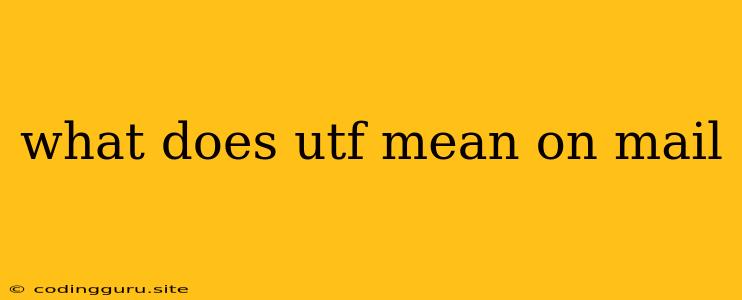What Does UTF Mean on Mail?
Have you ever wondered what "UTF" means in the context of your email? You might have seen it in the settings, noticed it as a part of the subject line, or even wondered why your email looks different when it's sent to someone else. Let's dive into the world of character encoding and understand what UTF signifies in the world of email communication.
The Need for Encoding
Email, at its core, is just a bunch of bits and bytes. These bits and bytes need to be translated into readable characters that humans can understand. This translation is done through something called "character encoding."
Think of character encoding like a dictionary. Every character you see on your screen, from letters to numbers to emojis, has a corresponding number in this dictionary. When you send an email, the software uses this dictionary to convert characters into numbers, and then back again when the recipient receives the email.
UTF: The Universal Standard
UTF stands for Unicode Transformation Format. It's a standard way of encoding characters that allows for a much wider range of characters than older encoding schemes.
Why is this important? Well, consider the diversity of languages in the world. Different languages have different characters. A simple encoding scheme might only be able to handle characters from a particular language like English. However, UTF is designed to handle characters from practically every language in the world, including:
- Latin-based languages: English, French, Spanish, German, etc.
- Cyrillic languages: Russian, Ukrainian, Serbian, Bulgarian, etc.
- Asian languages: Chinese, Japanese, Korean, Thai, etc.
- Special characters: Emojis, mathematical symbols, technical symbols, etc.
Why UTF Matters in Email
UTF ensures that your email message looks the same to the recipient as it does to you. Without UTF, there's a high chance that:
- Characters might be replaced with question marks or other strange symbols. Imagine sending an email with a French word containing accents and the recipient seeing only "????".
- Emojis might not display properly. Ever sent a funny emoji and it showed up as a blank square on the other end? This is often due to improper character encoding.
- Special characters or symbols used in your email may not be rendered correctly. This could be anything from scientific symbols to currency symbols.
How to Make Sure Your Email is Using UTF
- Check your email client settings. Most email clients, like Gmail, Outlook, or Yahoo Mail, allow you to choose your preferred character encoding. You usually find this setting in the options or preferences menu. Make sure UTF-8 is selected as your default encoding.
- Look for encoding options when you compose a new email. Some email clients might have an option to specify the encoding for individual emails. Choose UTF-8 if it's available.
- If you're sending an email to someone who might not support UTF-8, you can choose a more basic encoding scheme like ASCII. However, this will limit the characters you can use in your email.
Examples
Let's consider a few examples:
- Sending an email with a Japanese word: If your email client doesn't use UTF, the Japanese word might be displayed incorrectly.
- Using emojis in your email: If the recipient's email client isn't configured to handle UTF, the emojis might appear as blank squares or question marks.
In Conclusion
UTF is a critical standard for email that ensures everyone can read and understand the messages they receive, regardless of their language or the characters used. By understanding how UTF works and making sure your email clients are properly configured, you can avoid miscommunication and ensure that your emails are displayed correctly for all recipients.
